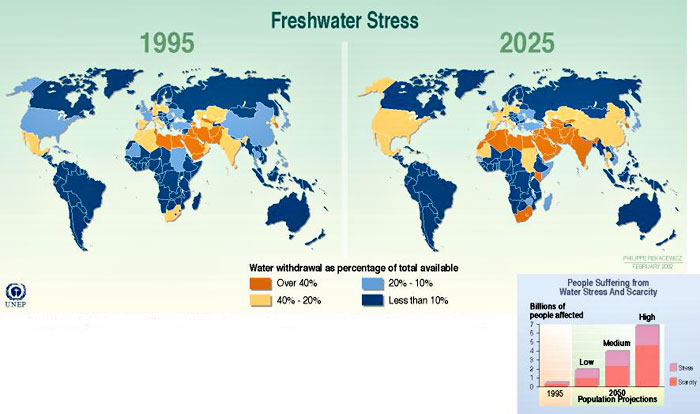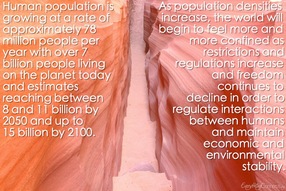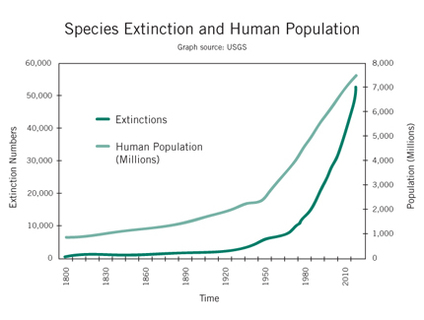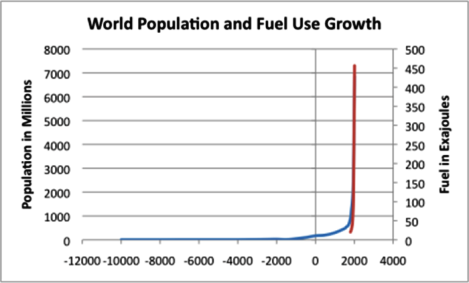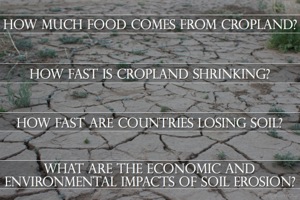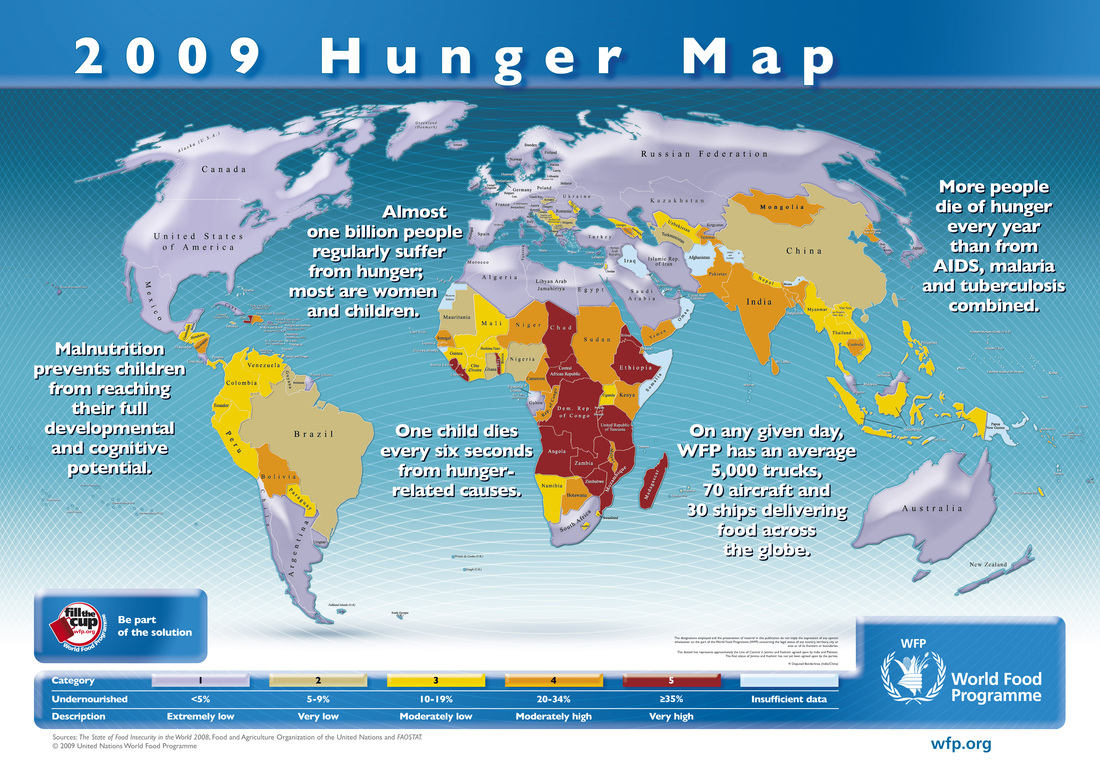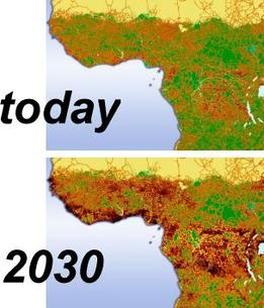Effects of Human Overpopulation
|
Navigation
|

Human overpopulation is among the most pressing environmental issues, silently aggravating the forces behind global warming, environmental pollution, habitat loss, the sixth mass extinction, intensive farming practices and the consumption of finite natural resources, such as fresh water, arable land and fossil fuels, at speeds faster than their rate of regeneration. However, ecological issues are just the beginning...
|
|
Loss of Fresh Water
According to UN-Water, 75% of planet Earth is covered in water. 97.5% of that is ocean and 2.5% is freshwater. 70% of freshwater is divided into glaciers and ice caps and the remaining 30% into land surface water, such as rivers, lakes, ponds and groundwater. Most of the freshwater resources are either unreachable or too polluted, leaving less than 1% of the world's freshwater, or about 0.003% of all water on Earth, readily accessible for direct human use. According to the Global Outlook for Water Resources to the Year 2025, it is estimated that by 2025, more than half of the world population will be facing water-based vulnerability and human demand for water will account for 70% of all available freshwater. Furthermore, a report in November 2009 by the 2030 Water Resources Group suggests that by 2030, in some developing regions in the world, water demand will exceed supply by 50% and a report jointly produced by more than two dozen U.N. bodies states that, "By 2030, nearly half of the world's people will be living in areas of acute water shortage." The planet is in the midst of what the United Nations is calling a "Global Water Crisis." Freshwater is the most fundamental finite resource with no substitutes for most uses, yet we are consuming fresh water at least 10 times faster than it is being replenished in regions of northern Africa, the Middle East, India, Pakistan, China, and the U.S.. According to the World Resources Institute, "Freshwater ecosystems – the diverse communities found in lakes, rivers, and wetlands – may be the most endangered of all. Some 34 percent of fish species, mostly from fresh water, are threatened with extinction, according to the latest tally of the World Conservation Union (IUCN), which tracks threats to the world’s biodiversity. Freshwater ecosystems have lost a greater proportion of their species and habitat than ecosystems on land or in the oceans; in addition, they are probably in greater danger of further losses from dams, pollution, overfishing, and other threats. In extent, freshwater ecosystems are quite limited, covering only about 1 percent of the Earth’s surface. Yet, they are highly diverse and contain a disproportionately large number of the world’s species." As human populations grow, so will the problem of clean freshwater availability. Finite Earth: Fresh Water
“We never know the worth of water till the well is dry.” ~Thomas Fuller Less Freedom, More Restrictions As population densities increase, laws, which serve as a primary social mediator of relations between people, will more frequently regulate interactions between humans and develop a need for more rules and restrictions to regulate these interactions. Aldous Huxley predicted in 1958 that democracy is threatened due to overpopulation and could give rise to totalitarian style governments and it turns out he was right. Rules and restrictions can be good ideas, but only because they are necessary in order to accommodate the growing populations that are encouraging such policies. Without these policies, the global ecological crisis, and the societal and economic issues that ensue, would be worse than they are today. Examples of such restrictions would be putting limits on water consumption, on driving and on what people can do on their land. Some are good ideas while others may be too invasive, but all are exacerbated by overpopulation. Learn more.
Increased Global Warming and Climate Change According to the Center for Biological Diversity, "The largest single threat to the ecology and biodiversity of the planet in the decades to come will be global climate disruption due to the buildup of human-generated greenhouse gases in the atmosphere. People around the world are beginning to address the problem by reducing their carbon footprint through less consumption and better technology. But unsustainable human population growth can overwhelm those efforts, leading us to conclude that we not only need smaller footprints, but fewer feet." Every national academy of science of every major country in the world agrees. Every professional scientific society in every field related to the field of climate endorses it. 97-98 percent of all scientists that are most active in publishing in the field of climate science agree with it. The consensus is unequivocal: human activities are causing climate change. The effects of climate change are profound and far-reaching. Learning the hard way that we can't separate the economy from the ecological systems that support it, climate change, perhaps the greatest challenge and threat humanity has ever faced, has been left largely unchecked by world leaders to continue unabated threatening the basis of civilization itself. Learn More.
Chart: Center for Biological Diversity. Data Source: EIA | Click to enlarge
|
Species Extinction
Human beings are currently causing the greatest mass extinction of species since the extinction of the dinosaurs 65 million years ago at rates 1000 to 10,000 times faster than normal. The 2012 update of the IUCN Red List of Threatened Species shows that of the 63,837 species examined worldwide, 19,817 are threatened with extinction - nearly a third of the total. If present trends continue, scientists warn that within a few decades, at least half of all plant and animal species on Earth will be extinct, as a result of climate change, habitat loss, pollution, acidifying oceans, invasive species, over-exploitation of natural resources, overfishing, poaching and human overpopulation. Human overpopulation has been dominating planetary physical, chemical, and biological conditions and limits, with an annual absorption of 42% of the Earth’s terrestrial net primary productivity, 30% of its marine net primary productivity, 50% of its fresh water, 40% of its land devoted to human food production, up from 7% in 1700, 50% of its land mass being transformed for human use and atmospheric nitrogen being fixated by humans than all other natural processes combined. Compared to the natural background rate of one extinction per million species per year, we are now losing 30,000 species per year, or three species per hour, which is faster than new species can evolve. The chart below further exemplifies the correlation between human population and species extinction. Learn more.
Depletion of Natural Resources As the human population continues to explode, finite natural resources, such as fossil fuels, fresh water, arable land, coral reefs and frontier forests, continue to plummet, which is placing competitive stress on the basic life sustaining resources and leading to a diminished quality of life. (see also) A study by the UNEP Global Environment Outlook, which involves 1,400 scientists and five years worth of work to prepare, found that "Human consumption had far outstripped available resources. Each person on Earth now requires a third more land to supply his or her needs than the planet can supply." Furthermore, the Millennium Ecosystem Assessment, which is a four-year research effort by 1,360 of the world's leading scientists commissioned to measure the actual value of natural resources to humans and the world, concluded that, "The structure of the world's ecosystems changed more rapidly in the second half of the twentieth century than at any time in recorded human history, and virtually all of Earth's ecosystems have now been significantly transformed through human actions." Explore 'Finite Earth'
More Intensive Farming Practices Intensive farming practices produce more and cheaper food per acre and animal, which has helped feed a booming human population and may prevent surrounding land from being converted into agricultural land, but has grown to become the biggest threat to the global environment through the loss of ecosystem services and global warming, has led to the emergence of new parasites and re-emergence of parasites previously considered to be 'under control' by creating the conditions for parasite growth and is responsible for 80% of tropical deforestation (see also). Furthermore, intensive farming kills beneficial insects and plants, degrades and depletes the very soil it depends on, creates polluted runoff and clogged water systems, increases susceptibility to flooding, causes the genetic erosion of crops and livestock species around the world, decreases biodiversity, and destroys natural habitats. Learn more.
Elevated Crime Rate As human overpopulation drives resources and basic necessities, such as food and water, to become scarcer, there will be increased competitiveness for these resources which leads to elevated crime rates due to drug cartels and theft by people in order to survive. As Aisha Tariq of the Pakistan Times states, "It has been observed that the countries which have balanced population, crime rate is very low in such regions. When people are not provided with the basic necessities, it elevates crime rate."
|
Lower Life Expectancy in the Fastest Growing Countries
According to a Harvard study, "Over the next forty years, nearly all (97%) of the 2.3 billion projected increase will be in the less developed regions, with nearly half (49%) in Africa." Already strained with relentless population explosion, many developing countries, such as in Sub Saharan Africa and Southern Asia, will experience a degradation of their quality and length of life as they face increasing difficulties to supply water, food, energy and housing to their growing populations, which will have major repercussions for public health, security measures and economic growth. These situations are especially dire for populations in Uganda, Nigeria, and Bangladesh, which will double and, in some cases, even triple over the next 40 years. Learn more.
Increased Emergence of New Epidemics and Pandemics A WHO report shows that environmental degradation, combined with the growth in world population, is a major cause of the rapid increase in human diseases, which contributes to the malnutrition of 3.7 billion people worldwide, making them more susceptible to disease. According to the World Health Organization, "Every three seconds a young child dies - in most cases from an infectious disease. In some countries, one in five children die before their fifth birthday. Every day 3 000 people die from malaria - three out of four of them children. Every year 1.5 million people die from tuberculosis and another eight million are newly infected." Overpopulation exacerbates many social and environmental factors, including overcrowded living conditions, pollution, malnutrition and inadequate or non-existent health care, which wreak havoc on the poor and increase their likelihood of being exposed to infections diseases. Learn more.
Increased Habitat Loss Human overpopulation is a major driving force behind the loss of ecosystems, such as rainforests, coral reefs, wetlands and Arctic ice. Rainforests once covered 14% of the Earth's land surface, now they cover a bare 6% and experts estimate that the last remaining rainforests could be consumed in less than 40 years and certainly by the end of the century at the current rate of deforestation. Due mainly to warming temperatures, acidifying oceans and pollution, close to 30% of the ocean’s reefs have already vanished since 1980, including half of the reefs in the Caribbean and 90% of the Philippines’ coral reefs, and scientists forecast that Australia’s Great Barrier Reef may be dead by the year 2050 and all coral reefs could be gone by the end of the century. Furthermore, the area of permanent ice cover is now declining at a rate of 11.5% per decade, relative to the 1979 to 2000 average. If this trend continues, summers in the Arctic could become ice-free in as few as 4 years or in the next 30 years. Wetlands are increasingly under threat in the United States, but also all over the world. In the U.S., less than half of original wetlands remain with 53% being lost, which is about 104 million acres. In Europe, between 60% and 70% of wetlands have been completely destroyed. As human populations continue to grow, so will our footprint on the interconnected, ecological infrastructures of life. Learn more.
IAP (Global Network of Science Academies) Statement on Population and Consumption
|
*Note: The effects listed on this page are just some of the main problems associated with or exacerbated by human overpopulation. A comprehensive list of the effects of human overpopulation are beyond compiling and perhaps, comprehension. They extend far and wide and across social, political, economic and environmental divides. Everything is affected.
"For several years population has been increasing faster than many vital non-renewable and renewable resources. This means the amount of these resources per person is declining, in spite of modern technology. Other massive social and environmental problems ... political instability, loss of freedoms, vanishing species, rain forest destruction, desertification, garbage, urban sprawl, water shortages, traffic jams, toxic waste, oil spills, air and water pollution, increasing violence and crime ... continue to worsen as our numbers increase by more than 70 million more people every year. Solving these problems will be much less difficult when we stop increasing the number of people affected by them. Two billion people live in poverty, more than the population of the entire planet less than 100 years ago. Today there are more people suffering in misery and starvation in the world than ever before in history." ~World Population Balance
|
|
|
Last Revised: 11/20/13
Commenting Rules |

